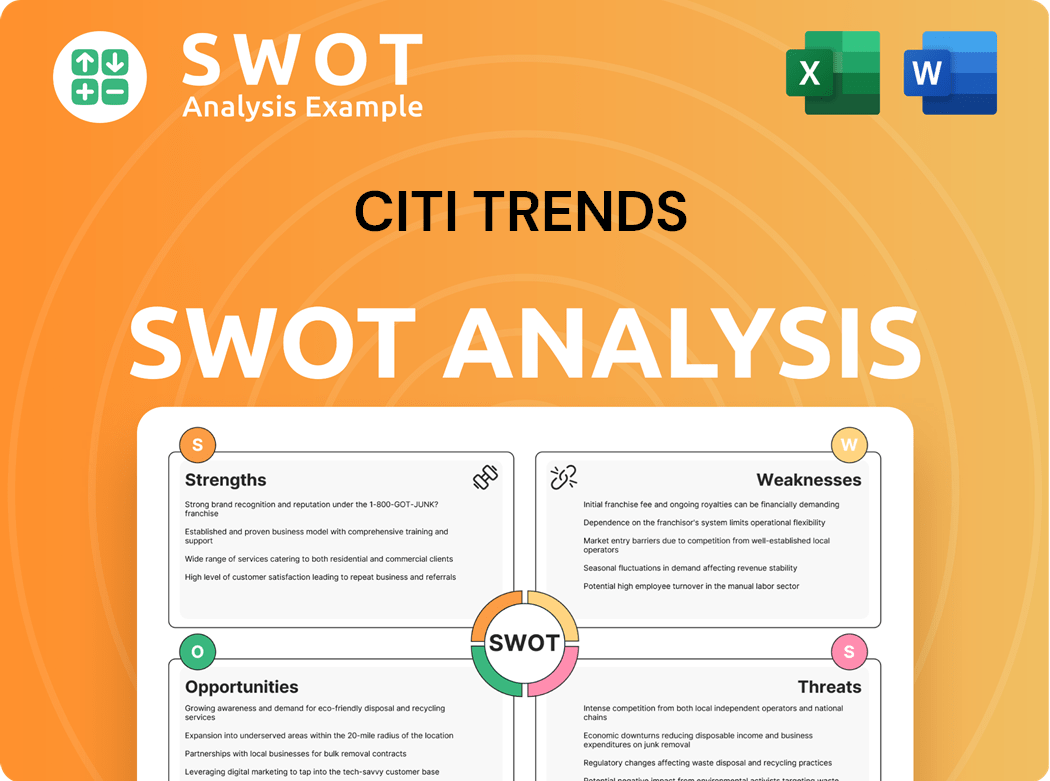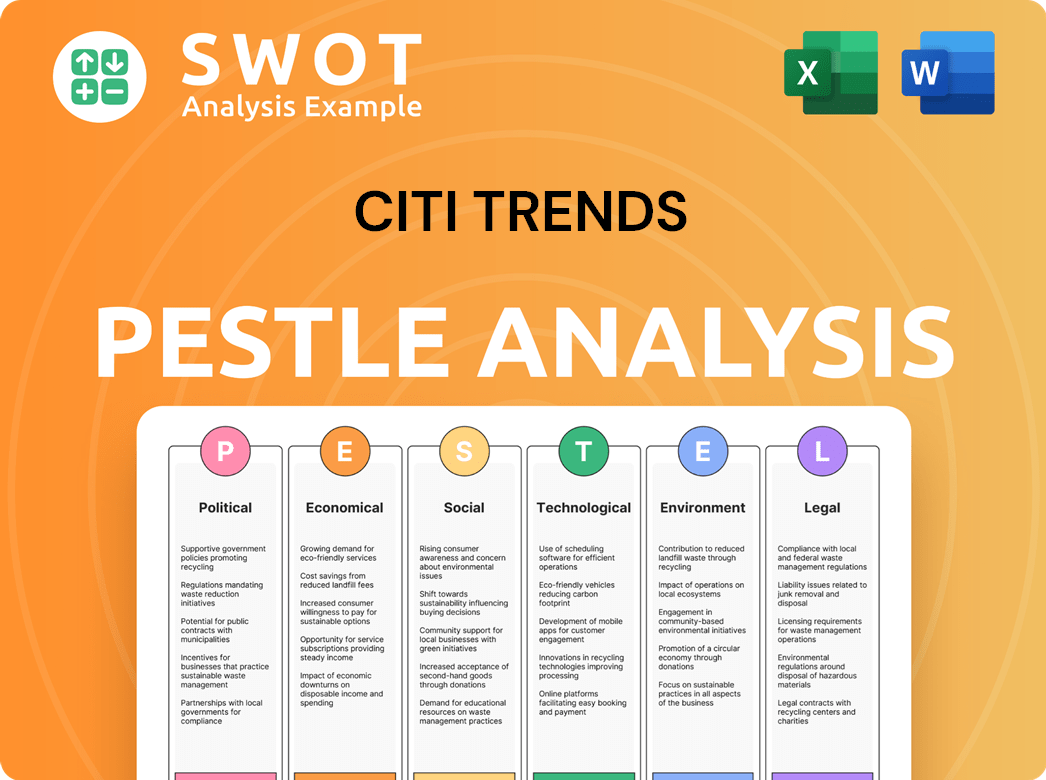Citi Trends Bundle
Can Citi Trends Continue Its Impressive Growth Trajectory?
Citi Trends, a prominent player in the discount fashion market, is captivating budget-conscious consumers with its value-priced urban apparel and home décor. With recent financial successes, including strong comparable store sales growth and a surge in total sales, the company is clearly undergoing a strategic transformation. This Citi Trends SWOT Analysis will help you to understand the company's strengths, weaknesses, opportunities, and threats.

As Citi Trends navigates the ever-evolving retail industry trends, understanding its Citi Trends growth strategy and future prospects is crucial. This analysis will delve into the company's business model, expansion plans, and competitive advantages, providing insights into its potential for long-term success. We will also explore how Citi Trends is positioned within the discount fashion market and what drives its Citi Trends financial performance.
How Is Citi Trends Expanding Its Reach?
The expansion strategy for Citi Trends focuses on a dual approach: optimizing existing stores and strategically adding new locations. This strategy aims to enhance market share and adapt to evolving retail industry trends. The company's approach reflects a commitment to sustainable growth rather than rapid expansion, ensuring long-term financial performance.
Citi Trends' future prospects involve a careful balance of remodeling existing stores and opening new ones. This approach allows the company to refresh its brand while expanding its footprint in key markets. The company is also focusing on product intensification, which will help to diversify revenue streams and better serve its target customer base.
This strategic direction is particularly important in the discount fashion market, where consumer preferences and economic conditions can shift rapidly. The company's ability to adapt and respond to these changes will be crucial for maintaining its competitive advantage and driving future growth. For more information on the company's ownership structure, you can read about the Owners & Shareholders of Citi Trends.
In fiscal 2025, Citi Trends plans to remodel approximately 50 stores to refresh their environments. The company intends to open up to 5 new stores while closing up to 5 underperforming locations. This strategic approach prioritizes fleet optimization.
Following detailed market studies, the company will identify priority metropolitan statistical areas (MSAs) for expansion. This will involve both backfilling existing markets and entering new, select markets. The company expects to ramp up new store growth in 2026 and beyond.
Citi Trends is focusing on product intensification in key areas. These include big men's, women's plus size, family footwear, consumables, and extreme value off-price deals. This strategy aims to better serve their target customer base.
Incorporating 'off-price' into its business model allows Citi Trends to offer high-margin, branded products at competitive prices. This is particularly advantageous during periods of economic uncertainty. This approach helps to maintain and grow market share.
Citi Trends' expansion initiatives are designed to drive sustainable growth. The company's focus on remodeling stores and opening new locations is a key part of this strategy. The company is also focused on product intensification and leveraging its off-price business model.
- Remodeling approximately 50 stores in fiscal 2025.
- Opening up to 5 new stores in fiscal 2025.
- Closing up to 5 underperforming locations in fiscal 2025.
- Ramping up new store growth in 2026 and beyond.
Citi Trends SWOT Analysis
- Complete SWOT Breakdown
- Fully Customizable
- Editable in Excel & Word
- Professional Formatting
- Investor-Ready Format

How Does Citi Trends Invest in Innovation?
The company is actively embracing technology and innovation to enhance its operational efficiency and improve the customer experience. This strategic focus is crucial for navigating the dynamic retail industry trends and maintaining a competitive edge in the discount fashion market.
A key element of the company's strategy involves implementing AI-based product allocation systems. This technology is designed to significantly impact inventory efficiency, reducing the time it takes for products to move from the vendor to the store. This agility allows the company to respond more quickly to evolving sales trends.
These enhancements to the supply chain are intended to improve inventory turns and boost working capital efficiency, which are vital for sustained financial performance. The company's ability to adapt and optimize its operations is critical for achieving its growth objectives and maintaining its position in the market.
The implementation of AI-based product allocation systems is a cornerstone of the company's innovation strategy. This technology is designed to optimize inventory management and reduce the time it takes for products to reach stores.
Improvements in the supply chain are aimed at enhancing inventory turns and working capital efficiency. These improvements are essential for driving revenue growth and maintaining profitability.
The company's focus on digital transformation is evident in its efforts to streamline internal processes. This includes improving product allocation and enhancing the overall customer experience.
The company emphasizes improving its ability to edit style and trends while delivering value-branded offerings. This approach helps to enhance its value proposition for shoppers and maintain a competitive edge.
By focusing on innovation, the company aims to improve the customer experience. This includes ensuring the right products are available in stores at the right time, ultimately contributing to increased sales.
Technological and operational improvements are crucial for driving sustained growth. These advancements contribute to increased sales and improved margins, supporting the company's overall financial goals.
While specific details on research and development investments or patents are not publicly highlighted, the company's focus on digital transformation is clear. The emphasis on 'improving our ability to edit style and trends, while delivering extreme value branded offerings and buzz-worthy products' suggests an innovative approach to merchandising and product selection. These improvements are crucial for driving sustained growth by ensuring the right products are in the right stores at the right time, contributing to increased sales and improved margins. For a deeper dive into the company's strategic initiatives, you can explore the Citi Trends company analysis.
The company is leveraging AI and digital solutions to enhance its operations and customer experience. These initiatives are designed to improve efficiency and drive growth.
- AI-Powered Inventory Management: Implementing AI-based systems to optimize product allocation and reduce time from vendor to store.
- Supply Chain Optimization: Enhancing supply chain processes to improve inventory turns and working capital efficiency.
- Digital Transformation: Streamlining internal processes and improving product selection to enhance the customer experience.
- Merchandising Innovation: Focusing on editing styles and trends to deliver value-branded offerings and buzz-worthy products.
Citi Trends PESTLE Analysis
- Covers All 6 PESTLE Categories
- No Research Needed – Save Hours of Work
- Built by Experts, Trusted by Consultants
- Instant Download, Ready to Use
- 100% Editable, Fully Customizable

What Is Citi Trends’s Growth Forecast?
The financial outlook for the company reflects a positive trajectory, building on recent performance and strategic initiatives. The company's focus on disciplined cost management and strategic investments positions it for sustained growth in the competitive retail landscape. Understanding the Revenue Streams & Business Model of Citi Trends is crucial for investors and analysts evaluating its future prospects.
For fiscal year 2024, total sales reached $753.1 million, showing a 0.7% increase compared to fiscal year 2023. This growth was supported by a 3.4% increase in comparable store sales, demonstrating the effectiveness of the company's retail strategies. The company's focus on the discount fashion market and its ability to adapt to retail industry trends are key drivers of its financial performance.
Looking ahead to fiscal 2025, the company anticipates continued growth. Projections include mid-single-digit comparable store sales growth, indicating confidence in its ability to attract and retain customers. This is a critical factor when considering Citi Trends' investment potential and its ability to navigate the discount fashion market.
For fiscal year 2024, total sales were $753.1 million, with a 0.7% increase from the previous year. Comparable store sales rose by 3.4%. The company's financial performance reflects its ability to compete effectively within the discount fashion market.
Gross margin is expected to expand by approximately 200 basis points in fiscal 2025 compared to fiscal 2024. This expansion is aimed at ensuring that gross margin dollar growth outpaces sales growth, contributing to overall profitability.
Selling, General, and Administrative (SG&A) expenses are projected to leverage in the range of 60 to 80 basis points versus 2024. This indicates disciplined cost controls and improved operational efficiency, which are crucial for long-term sustainability.
Full-year EBITDA for fiscal 2025 is projected to be between $6 million and $10 million. Capital expenditures are expected to be between $18 million and $22 million, supporting new store openings and remodels, indicating expansion plans for 2024.
The company's strong financial position is further supported by its robust liquidity. At the end of fiscal 2024, the company had approximately $61 million in cash and no debt, with a total liquidity of around $136 million. As of Q1 2025, liquidity remained strong at approximately $117.0 million with $41.6 million in cash and no debt, providing a solid foundation for future investments and expansion. The company's share repurchase program, with $40.0 million remaining as of Q1 2025, also reflects management's confidence in the company's value. These financial metrics are key indicators for anyone analyzing Citi Trends’ competitive advantages and its overall market share analysis.
The financial outlook for Citi Trends shows positive growth, driven by strategic initiatives and disciplined financial management. These factors are crucial when assessing the company's future outlook and its ability to adapt to retail industry trends.
- Comparable store sales growth is projected in the mid-single digits for fiscal 2025.
- Gross margin is expected to expand by approximately 200 basis points.
- SG&A expenses are anticipated to leverage in the range of 60 to 80 basis points.
- Full-year EBITDA for fiscal 2025 is projected to be between $6 million and $10 million.
- Capital expenditures are planned between $18 million and $22 million.
- The company maintains a strong liquidity position with approximately $117.0 million as of Q1 2025.
Citi Trends Business Model Canvas
- Complete 9-Block Business Model Canvas
- Effortlessly Communicate Your Business Strategy
- Investor-Ready BMC Format
- 100% Editable and Customizable
- Clear and Structured Layout

What Risks Could Slow Citi Trends’s Growth?
The success of Citi Trends's growth strategy and its future prospects face several potential risks. The retail apparel sector is highly competitive, and the company must navigate challenges like changing fashion trends and supply chain vulnerabilities. Macroeconomic factors and seasonal sales fluctuations also pose significant hurdles that could impact financial performance.
One key risk is the intense competition within the discount fashion market. Larger competitors often have greater resources, potentially leading to pricing pressures and market share loss. The company's reliance on rapidly evolving fashion trends means that any failure to accurately predict and respond could lead to decreased demand and excess inventory.
Supply chain disruptions and macroeconomic pressures also represent significant challenges. The company’s target demographic, budget-conscious customers, makes it particularly vulnerable to economic downturns. These factors could affect the company's ability to achieve its growth objectives.
Intense competition in the retail industry could lead to pricing pressures and market share loss. Larger competitors with greater resources pose a constant challenge. The company must continuously innovate and adapt to stay competitive within the discount fashion market.
Rapidly changing fashion trends present a significant risk. Failure to anticipate and respond effectively could result in decreased demand and increased markdowns. The company needs to accurately forecast trends to manage inventory and maintain profitability.
Supply chain disruptions could lead to inventory shortages or excesses, affecting sales and profitability. The company's supply chain transformation is crucial, but an elongated timeline for the 'repair phase' could impact gross margin expansion. Effective supply chain management is essential for the company's success.
Macroeconomic factors such as inflation and unemployment can negatively impact sales. The company's budget-conscious customer base is particularly sensitive to economic downturns. Monitoring and adapting to these economic shifts is vital for maintaining financial performance.
The company's business is subject to seasonal fluctuations, with significant sales concentrated in the first and fourth quarters. Adverse events during these peak periods could severely affect annual results. Strategic planning is needed to manage inventory and sales during these periods.
The absence of a robust online sales platform could be a disadvantage as consumer spending shifts towards e-commerce. Expanding its online presence is crucial for capturing a broader market share. Developing a strong e-commerce strategy will be essential for future growth.
To mitigate these risks, Citi Trends is focusing on maintaining ample liquidity. It is also diversifying product offerings and implementing strategic initiatives. AI-based allocation systems are being used to improve inventory efficiency and responsiveness. These strategies are designed to strengthen the company's position in the discount fashion market.
In 2024, the retail industry faced challenges, with many companies experiencing fluctuations in sales and profitability. Factors such as inflation and shifts in consumer spending patterns significantly impacted financial results. The company's ability to manage these challenges will determine its future success. In the first quarter of 2024, the company reported a net sales decrease of 3.1% to $196.6 million.
Citi Trends Porter's Five Forces Analysis
- Covers All 5 Competitive Forces in Detail
- Structured for Consultants, Students, and Founders
- 100% Editable in Microsoft Word & Excel
- Instant Digital Download – Use Immediately
- Compatible with Mac & PC – Fully Unlocked

Related Blogs
- What are Mission Vision & Core Values of Citi Trends Company?
- What is Competitive Landscape of Citi Trends Company?
- How Does Citi Trends Company Work?
- What is Sales and Marketing Strategy of Citi Trends Company?
- What is Brief History of Citi Trends Company?
- Who Owns Citi Trends Company?
- What is Customer Demographics and Target Market of Citi Trends Company?
Disclaimer
All information, articles, and product details provided on this website are for general informational and educational purposes only. We do not claim any ownership over, nor do we intend to infringe upon, any trademarks, copyrights, logos, brand names, or other intellectual property mentioned or depicted on this site. Such intellectual property remains the property of its respective owners, and any references here are made solely for identification or informational purposes, without implying any affiliation, endorsement, or partnership.
We make no representations or warranties, express or implied, regarding the accuracy, completeness, or suitability of any content or products presented. Nothing on this website should be construed as legal, tax, investment, financial, medical, or other professional advice. In addition, no part of this site—including articles or product references—constitutes a solicitation, recommendation, endorsement, advertisement, or offer to buy or sell any securities, franchises, or other financial instruments, particularly in jurisdictions where such activity would be unlawful.
All content is of a general nature and may not address the specific circumstances of any individual or entity. It is not a substitute for professional advice or services. Any actions you take based on the information provided here are strictly at your own risk. You accept full responsibility for any decisions or outcomes arising from your use of this website and agree to release us from any liability in connection with your use of, or reliance upon, the content or products found herein.